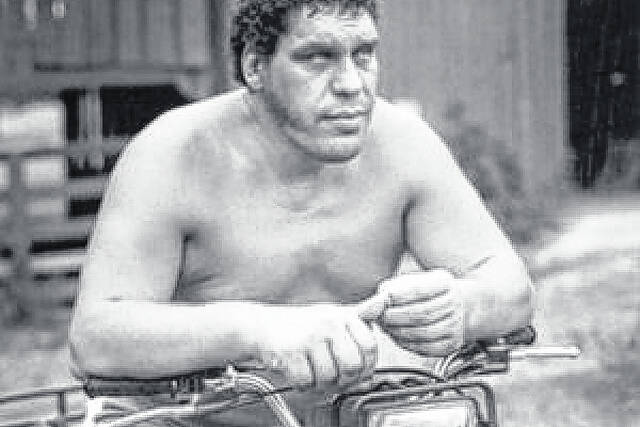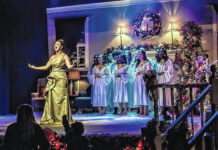
Andre Roussimoff in Grenoble died at his ranch in Ellerbe in 1993. His ashes were scattered there after his death.
Photo courtesy the NC Dept. of Natural and Cultural History
North Carolina History
Jan. 27: Gentle Giant Andre Roussimoff Settled in Ellerbe: On January 27, 1993, Andre the Giant, world-famous wrestler and Richmond County resident, died in France.
Born Andre Roussimoff in Grenoble, France in 1946, he suffered from acromegaly, a result of a pituitary disorder that caused his body to over-produce growth hormones. He grew to be giganitic, later billed at 7’4” and 500 pounds. At 17, Andre moved to Paris, where he was discovered by a wresting promoter. He trained and worked hard at the sport. He enjoyed success in several countries and as a variety of personae before moving to the United States.
Here he became “Andre the Giant,” an immovable force who debuted at Madison Square Garden in 1973. He grew to be a fan favorite and one of the most recognized wrestlers in the business. Andre took advantage of his size when he branched out into acting in the 1970s. He appeared in several television shows, including The Six Million Dollar Man, B. J. and the Bear and The Fall Guy. His most celebrated role, and his personal favorite, was as Fezzik in the 1987 hit movie The Princess Bride.
Andre retired to a ranch in Ellerbe in the south central part of the state, where he enjoyed a peaceful life. His ashes were scattered there after his death.
Jan. 28: Fire Suppression Stymied at Wrightsville Beach, 1934: On January 28, 1934, a devastating fire destroyed much of Wrightsville Beach, including the legendary Oceanic Hotel.
Just after noon on that Sunday, smoke poured out of the Kitty Cottage, a boarding house on the north end of the island. In less than three hours, more than 100 buildings were leveled as the westerly wind took the fire from building to building via wooden-shingled roofs. The handful of permanent residents and the tiny volunteer fire department formed bucket brigades and pushed carts laden with hoses through the sand but, with no fire hydrants, it was a lost cause. Once the wind shifted to the southwest, the flames roared to more than 50 feet high and were so hot they could be felt on Harbor Island, between Wrightsville and the mainland.
The Wilmington Fire Department was called to assist but, with no vehicular bridge to the island, the heavy equipment was placed onto a trolley and, once on the island, sank into the sand as the wooden boardwalks had been burned as well. All that was left of the north end of the island was chimneys, iron bed frames and dead crabs littering the beach.
Jan. 28, Beaufort Native Michael Smith Died in Shuttle Explosion: On January 28, 1986, the Space Shuttle Challenger exploded just 73 seconds after its 11:38 a.m. launch from Kennedy Space Center in Florida. The seven crew members, including the pilot, U.S. Navy Captain Michael John Smith of Beaufort, North Carolina, died in the disaster. Investigators later determined that cold weather caused a seal in the craft’s right solid rocket booster to fail, allowing pressurized hot gas from the solid rocket motor to reach the external fuel tank. The spacecraft broke apart and disintegrated in a plume of white smoke over the Atlantic Ocean.
The fatal mission (Flight STS-51L), which was to have deployed two satellites into orbit, received much media attention because it marked the first time a civilian, high school teacher Christa McAuliffe, was allowed to travel in space. After the disaster, NASA suspended shuttle flights for two years. The Challenger’s remains were recovered from the ocean floor nearly two months after the explosion. Captain Smith was buried in Arlington National Cemetery on May 3, 1986. There is a monument to Smith on the waterfront in Beaufort and the town’s Michael J. Smith Airport is named in his honor.
Jan. 31: The Carroll A. Deering, “Ghost Ship”: On January 31, 1921, the impressive five-masted commercial schooner Carroll A. Deering was found wrecked on Diamond Shoals off Cape Hatteras. At the time, she was returning to Newport News from a trip to Brazil. Built in 1919 by the G. G. Deering Company in Bath, Maine, the ship was among the last wooden schooners built before their eclipse by iron shipbuilding.
Two days before the discovery of the wreck, the Cape Lookout Lighthouse keeper reported seeing the ship. A crew member yelled that the ship had lost its anchors and it continued sailing on. On the morning of the 31st, the Coast Guard discovered the foundered boat, ostensibly abandoned.
When the seas calmed four days later and the Coast Guard was able to reach the ship, it was clear the vessel had been abandoned—the crew and their navigational equipment, belongings, documents and lifeboats were all gone, but interestingly dinner was on the stove and the captain’s cabin was a mess. A few months later, the ship was dynamited so it wouldn’t be a hazard to mariners in the area. The mysterious circumstances of the wreck became the subject of investigation which included a visit to Dare County by the FBI. Various explanations for the wreck surfaced, including pirates, mutiny, and the effects of the ship having travelled through the Bermuda Triangle. The cause remains a mystery. Scorce: North Carolina Department of Natural and Cultural Resources
Jan. 31, American Tobacco Company: On January 31, 1890, the American Tobacco Company was incorporated, creating the world’s largest tobacco conglomerate. Driving the creation of this industrial giant was James B. “Buck” Duke of the Durham-based W. Duke, Sons and Company. Facing tough competition from another Durham-based smoking tobacco firm, Duke had decided in 1881 to enter the cigarette business.
By leasing newly invented cigarette-rolling machines from the Bonsack Company of Virginia, launching elaborate advertising campaigns and acquiring many smaller competitors, W. Duke Sons had become one of the nation’s top tobacco companies by 1890.
Joining with W. Duke Sons that year to form American Tobacco were Allen & Ginter, W. S. Kimball & Company, Kinney Tobacco and Goodwin & Company. Under Duke’s leadership, American Tobacco grew to monopolize the tobacco market, and in 1907, federal regulators filed an anti-trust suit against the corporation. After much litigation, the U.S. Supreme Court ordered it dissolved in 1911.
Duke helped reorganize American Tobacco into three companies: a much smaller American Tobacco, Liggett and Myers Tobacco Company and P. Lorillard Company. During the 1970s and 1980s, American Tobacco began acquiring a variety of non-tobacco products. It renamed itself American Brands in 1986, and since then, it has become Fortune Brands.
Jan. 31, The Wreck of the Metropolis, 1878: On January 31, 1878, the vessel Metropolis struck the shoals 100 yards from the beach at Currituck, halfway between two lifesaving stations.
Built in 1861 and originally called the Stars and Stripes, the ship was outfitted for naval service in September 1862 and saw action during the Battle of Roanoke Island later that year. The ship was refitted for freight and passenger service but eventually fell into disrepair, rendering it inadequate for the longer trips.
Nonetheless, a Philadelphia company chartered the Metropolis to transport workmen and supplies to Brazil to build a railroad in January 1878. By the time the ship reached the Chesapeake Bay, the cargo was shifting dangerously, causing seams in the hull to leak.
On January 31 at 6:45 a.m., the ship hit the shoals. Alarms were sounded and heroic efforts mounted but to no avail. Of the 245 passengers aboard, 85 died in the wreck.
The wreck of the Metropolis—combined with that of the USS Huron two months earlier— captured the attention of Congress and prompted it to authorize the construction of new life-saving stations.
Feb. 1, Landmark Lunch Counter Protest in Greensboro: On February 1, 1960, four African American college students sat down at the lunch counter at Woolworth’s Department Store in downtown Greensboro and asked to be served. They were refused, launching a sit-in movement that would spread throughout North Carolina and the South.
The four students, Ezell Blair, Jr. (later known as Jibreel Khazan), Franklin E. McCain, Joseph A. McNeil and David L. Richmond, were all freshmen from nearby North Carolina A&T State University.
Sit-ins by college students during the next several months forced the integration of businesses in the region. Local media attention led to national coverage. The protest spurred similar efforts across the country, sparking a national call to battle by civil rights activists who endorsed the nonviolent form of protest to demonstrate society’s inequities for blacks.
In April 1960, the Student Nonviolent Coordinating Committee (SNCC), an outgrowth of the sit-in movement, organized at Shaw University in Raleigh. The sit-ins and demonstrations throughout the South, slowly led to changes in local attitudes.
Nationally, these and other protests ultimately led to the passage of the Civil Rights Act of 1964 and the Voting Rights Act of 1965, both of which assured the legal rights of blacks.
Feb. 1, Streetcars Debut in The Land of the Sky in 1889: Asheville’s first streetcar makes its 1889 debut. Image from the North Carolina Collection of the Pack Memorial Library.
On February 1, 1889, the first streetcar in North Carolina made its debut in Asheville. The first line extended from Pack Square down Biltmore Avenue and Southside Avenue, and then was routed west of present-day McDowell Street to a train depot.
The system’s roots can be traced to the previous year, when the city authorized a charter for an electric railway that would include lines from Pack Square to various sections of the city. E.D. Davidson, who had designed a Canadian horsecar railway, agreed to build the system in collaboration with Frank Sprague, who engineered the streetcar system in Richmond.
After the initial launch, a number of railway companies organized and built streetcar lines to emerging neighborhoods and outlying areas, including the Sulphur Springs resort and Biltmore Village. By 1907, Asheville led the state in streetcar traffic, carrying 3 million passengers annually, compared to Charlotte and Wilmington with 2 million each.
By 1915, the streetcar railway reached its peak, operating 43 cars on 18 miles of track, including one to the newly opened Grove Park Inn and the surrounding upscale neighborhood.
The system ceased operation in 1934 when it was supplanted by buses.
Feb. 2, Daring Raid Nets Union Vessel in 1864: On February 2, 1864, the 325-ton federal steamer USS Underwriter was captured at New Bern in a well-executed pre-dawn raid.
Led by Commander John Taylor Wood, the raid involved 14 boats carrying 250 sailors and marines stealthily making their way down the Neuse River from Kinston. Those participating in the mission had been selected from crews of Confederate vessels at Richmond, Wilmington and Charleston.
The Confederates boarded the Underwriter and, following fierce hand-to-hand combat, took control of the gunboat, capturing many of her officers and crew. Fourteen men were killed in the melee, five Confederate and nine Union, including the Underwriter’s commander.
Because the Underwriter’s fires were low the ship did not have enough steam to power it, its capture almost pointless. The Confederates set her afire and headed back up the Neuse River under Union fire from batteries on land, taking the prisoners with them. As the victors made their way away from burning Underwriter, they heard a terrific explosion when fire reached the vessel’s arsenal.
The loss of the Underwriter late during the Civil War proved that areas under heavy Union occupation were not impenetrable to Confederate raids.
Feb. 2, Newport Barracks Contested in 1864: On February 2, 1864, Confederate troops engaged the men of the 9th Vermont Infantry at the Newport Barracks in Carteret County.
The 7th Regiment North Carolina Infantry built the barracks south of Newport for quarters in the winter of 1861 and 1862. Shortly thereafter, the cluster of log huts was captured by Union troops, who added a hospital, headquarters, stables, storehouse and earthworks. Newport Barracks effectively became a Federal supply depot, since it was located near both the Atlantic Ocean and railroad tracks.
In January 1864, 2,000 Confederate troops under the command of General James G. Martin advanced from Wilmington toward Morehead City to support General George E. Pickett’s mission to regain control of New Bern. They reached the barracks on February 2. Company D of the 2nd Massachusetts Heavy Artillery, stationed inside Newport Barracks, prematurely abandoned their posts and retreated as the Confederates advanced. The commander of the 9th Vermont set fire to the depot and followed suit. The fleeing troops also burned the railroad and road bridges.
The skirmish was largely indecisive, though Martin’s men managed to capture 30 Union troops and gather some supplies and equipment from the barracks before they were destroyed. When the Confederate troops learned of Pickett’s failure at New Bern, they returned to Wilmington.
Nation and World History:
Jan. 27, three astronauts die in fire during test of Apollo spacecraft: Today’s Highlight in History: On Jan. 27, 1967, astronauts Virgil I. “Gus” Grissom, Edward H. White and Roger B. Chaffee died in a flash fire during a test aboard their Apollo spacecraft.
Jan. 28, space shuttle Challenger explodes: On Jan. 28, 1986, the space shuttle Challenger exploded 73 seconds after liftoff from Cape Canaveral, killing all seven crew members, including schoolteacher Christa McAuliffe.
Jan. 29, Ty Cobb and Babe Ruth become first baseball Hall of Fame inductees: On Jan. 29, 1936, the first inductees of baseball’s Hall of Fame, including Ty Cobb and Babe Ruth, were named in Cooperstown, New York.
Jan. 30, Hitler becomes German chancellor: On Jan. 30, 1933, Adolf Hitler became chancellor of Germany.
Jan. 31, US enters space age with launch of first satellite: On Jan. 31, 1958, the United States entered the Space Age with its first successful launch of a satellite, Explorer 1, from Cape Canaveral.
Feb. 1, space shuttle Columbia destroyed during re-entry: In Feb. 1, 2003, the space shuttle Columbia broke apart during re-entry, killing all seven of its crew members: commander Rick Husband; pilot William McCool; payload commander Michael Anderson; mission specialists Kalpana Chawla, David Brown and Laurel Clark; and payload specialist Ilan Ramon, the first Israeli in space.
Feb. 2, ‘American Sniper’ Chris Kyle killed: On Feb. 2, 2013, former Navy SEAL and “American Sniper” author Chris Kyle was fatally shot along with a friend, Chad Littlefield, at a gun range west of Glen Rose, Texas; suspect Eddie Ray Routh was later convicted and sentenced to life in prison without parole.
Feb. 3, the day the music died: On Feb. 3, 1959, which would become known as “the day the music died,” rock-and-roll stars Buddy Holly, Ritchie Valens and J.P. “The Big Bopper” Richardson died in a small plane crash near Clear Lake, Iowa.
Executive Editor David Kennard compiles This Week In History from Robesonian archives, the North Carolina Department of Natural and Cultural Resources and Associated Press reports.








